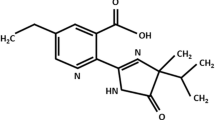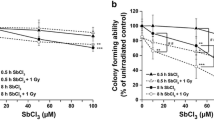Abstract
In order to clarify the molecular mechanisms of Sn2+ genotoxicity, we evaluated the induction of strand breaks, formamidopyrimidine DNA glycosylase (Fpg) and endonuclease III (Endo III) sensitive sites, and the interference with the repair of methyl methane sulfonate (MMS)-caused DNA damage in V79 Chinese hamster lung fibroblasts exposed to stannous chloride by comet assay. A concentration-related increase in the DNA damage induced by 2 h SnCl2 treatment at a concentration range of 50–1,000 μM was observed (r = 0.993; P < 0.01). Significantly elevated DNA migration in relation to the control level was detected at doses 100, 500 and 1,000 μM in normal alkaline and at doses 500 and 1,000 μM in modified (with Fpg and Endo III) comet assay. Although 50 μM SnCl2 concentration did not increase significantly the DNA migration by itself in comet assay, it was capable to inhibit the repair of MMS-induced DNA damage during the post-treatment period of 24 h. Our results demonstrate the genotoxic and comutagenic effects of stannous chloride in V79 cells. The inhibitory effect of Sn2+ on repair of MMS-induced DNA damage suggests that this metal can also interfere in DNA repair systems thus contributing to increased mutation by shifting the balance from error-free to error-prone repair processes.



Similar content being viewed by others
Abbreviations
- 8-oxoG:
-
8-Oxo-7,8-dihydroguanine
- AP sites:
-
Apurinic/apyrimidinic sites
- BER:
-
Base excision repair
- Endo III:
-
Endonuclease III
- Fpg:
-
Formamidopyrimidine DNA glycosylase
- MMS:
-
Methyl methane sulfonate
- ROS:
-
Reactive oxygen species
References
Ashby J, Tennant RW (1991) Definite relationships among chemical structure, carcinogenicity and mutagenicity for 301 chemical tested by the U.S. NTP. Mutat Res 257:229–306
Beyersmann D, Hartwig A (2008) Carcinogenic metal compounds: recent insight into molecular and cellular mechanisms. Arch Toxicol 82:493–512
Blunden S, Wallace T (2003) Tin in canned food: a review and understanding of occurrence and effect. Food Chem Toxicol 41:1651–1662
Burlinson B, Tice RR, Speit G, Agurell E, Brendler-Schwaab SY, Collins AR, Escobar P, Honma M, Kumaravel TS, Nakajima M, Sasaki YF, Thybaud V, Uno Y, Vasquez M, Hartmann A (2007) Fourth international workgroup on genotoxicity testing: results of the in vivo comet assay workgroup. Mutat Res 627:31–35
Cabral REC, Leitão AC, Lage C, Caldeira-de-Araújo A, Bernardo-Filho M, Dantas FJS, Cabral-Neto JB (1998) Mutational potentiality of stannous chloride: an important reducing agent in the Tc-99m-radiopharmaceuticals. Mutat Res 408:129–135
Collins AR, Duthie SJ, Dobson VL (1993) Direct enzymic detection of endogenous oxidative base damage in human lymphocyte DNA. Carcinogenesis 14:1733–1735
Collins AR, Ma AG, Duthie SJ (1995) The kinetics of repair of oxidative DNA damage (strand breaks and oxidised pyrimidines) in human cells. Mutat Res 336:69–77
Dantas FJ, Moraes MO, Carvalho EF, Valsa JO, Bernardo-Filho M, Caldeira-de-Araújo A (1996) Lethality induced by stannous chloride on Escherichia coli AB1157: participation of reactive oxygen species. Food Chem Toxicol 34:959–962
Dantas FJ, Moraes MO, de Mattos JC, Bezerra RJ, Carvalho EF, Filho MB, Caldeira de Araújo A (1999) Stannous chloride mediates single strand breaks in plasmid DNA through reactive oxygen species formation. Toxicol Lett 110:129–136
Dantas FJ, de Mattos JC, Moraes MO, Boasquevisques E, Rodrigues MP, Lage CA, Cabral-Neto JB, Leitão AC, Bernardo-Filho M, Bezerra RJ, Carvalho JJ, Caldeira-de-Araujo A (2002) DNA damage in peripheral blood nuclear cells assessed by comet assay from individuals submitted to scintigraphic examination. Cell Mol Biol 48:789–791
de Mattos JCP, Lage C, Dantas FJS, Moraes MO, Nunes APM, Bezerra RJAC, Faria MVC, Leitão AC, Caldeira-de-Araújo A (2005) Interaction of stannous chloride leads to alteration in DNA, triphosphate nucleotides and isolated bases. Mol Cell Biochem 280:173–179
Dherin C, Gasparutto D, O’Connor TR, Cadet J, Boiteux S (2004) Excision by the human methylpurine DNA N-glycosylase of cyanuric acid, a stable and mutagenic oxidation product of 8-oxo-7, 8-dihydroguanine. Int J Radiat Biol 80:21–27
El-Demerdash FM, Yousef MI, Zoheir MA (2005) Stannous chloride induces alterations in enzyme activities, lipid peroxidation and histopathology in male rabbit: antioxidant role of vitamin C. Food Chem Toxicol 43:1743–1752
El-Makawy A, Girgis SM, Khalil WK (2008) Developmental and genetic toxicity of stannous chloride in mouse dams and fetuses. Mutat Res (in press)
Hailer MK, Slade PG, Martin BD, Rosenquist TA, Sugden KD (2005) Recognition of the oxidized lesions spiroiminodihydantoin and guanidinohydantoin in DNA by the mammalian base excision repair glycosylases NEIL1 and NEIL2. DNA Repair 4:41–50
Harbert JL, Eckelman WC, Newman RD (1996) Nuclear medicine diagnosis and therapy. Thieme Medical Publishers, New York
Hartwig A, Schwerdtle T (2002) Interactions by carcinogenic metal compounds with DNA repair processes: toxicological implications. Toxicol Lett 127:47–54
Hartwig A, Asmuss M, Blessing H, Hoffmann S, Jahnke G, Khandelwal S, Pelzer A, Burkle A (2002) Interference by toxic metal ions with zinc-dependent proteins involved in maintaining genomic stability. Food Chem Toxicol 40:1179–1184
Kada T, Hirano K, Shirasu Y (1980) Screening of environmental chemical mutagens by the Rec-assay system with Bacillus subtilis. In: Hollaender A, de Serres FJ (eds) Chemical mutagens, principles and methods, for their detection, vol 6. Plenum, New York, pp 149–173
Kim JE, You HJ, Choi JY, Doetsch PW, Kim JS, Chung MH (2001) Ntg2 of Saccharomyces cerevisiae repairs the oxidation products of 8-hydroxyguanine. Biochem Biophys Res Commun 285:1186–1191
Lynn S, Lai HT, Gurr JR, Jan KY (1997) Arsenite retards DNA break rejoining by inhibiting DNA ligation. Mutagenesis 12:353–358
McLean JR, Blakey DH, Douglas GR, Kaplan JG (1983a) The effect of stannous and stannic (tin) chloride on DNA in Chinese hamster ovary cells. Mutat Res 119:195–201
McLean JR, Birmboim HC, Pontefact R, Kaplan JG (1983b) The effect of tin chloride on the structure and function of DNA in human white blood cells. Chem Biol Interact 46:189–200
McNeill DR, Wong HK, Narayana A, Wilson DM (2008) Lead promotes abasic site accumulation and co-mutagenesis in mammalian cells by inhibiting the major abasic endonuclease Ape1. Mol Carcinog 46:91–99
Møller P (2006) Assessment of reference values for DNA damage detected by the comet assay in human blood cell DNA. Mutat Res 612:84–104
Mosmann T (1983) Rapid calorimetric assay for cellular growth and survival. Application to proliferation and cytotoxic assays. J Immunol Methods 65:55–63
Nadin SB, Vargas-Roig LM, Ciocca DR (2001) A silver staining method for single-cell gel assay. J Histochem Cytochem 49:1183–1186
Olivier P, Marzin D (1987) Study of genotoxic potential of 48 inorganic derivatives with SOS chromotest. Mutat Res 189:263–269
Pungartnik C, Viau C, Picada J, Caldeira-de-Araújo A, Henriques JAP, Brendel M (2005) Genotoxicity of stannous chloride in yeast and bacteria. Mutat Res 583:146–157
Sancar A, Lindsey-Boltz LA, Unsal-Kacmaz K, Linn S (2004) Molecular mechanisms of mammalian DNA repair and the DNA damage checkpoints. Annu Rev Biochem 73:39–85
Singh NP, Mccoy T, Tice RR, Schneider EL (1988) A simple technique for of low levels of DNA damage in individual cells. Exp Cell Res 175:184–192
Speit G, Hartmann A (2006) The comet assay: a sensitive genotoxicity test for the detection of DNA damage and repair. Methods Mol Biol 314:275–286
Tice RR, Agurell E, Anderson D, Burlinson B, Hartmann A, Kobayashi H, Miyamae Y, Rojas E, Ryu JC, Sasaki YF (2000) Single cell gel/comet assay: guidelines for in vitro and in vivo genetic toxicology testing. Environ Mol Mutagen 35:206–221
Viau C, Pungartnik C, Schmitt MC, Basso TS, Henriques JAP, Brendel M (2006) Sensitivity to Sn2+ of the yeast Saccharomyces cerevisiae depends on general energy metabolism, metal transport, anti-oxidative defences, and DNA repair. Biometals 19:705–714
Woźniak K, Błasiak J (2002) Free radicals-mediated induction of oxidized DNA bases and DNA-protein cross-links by nickel chloride. Mutat Res 514:233–243
Acknowledgments
Research supported by Fundação de Amparo a Pesquisa do Estado do Rio Grande do Sul (FAPERGS), Conselho Nacional de Desenvolvimento Científico e Tecnológico (CNPq), and GENOTOX, Royal Institute. C. M. Viau held a CNPq fellowship and is a Ph.D. student from UFRGS, T. N. Guecheva is supported by CNPq, C. Pungartnik held a fellowship by CNPq (PRODOC/FAPESB/CNPq) and M. Brendel is Visiting Scientist at UESC supported by Fundação de Amparo a Pesquisa do Estado da Bahia (FAPESB).
Author information
Authors and Affiliations
Corresponding author
Rights and permissions
About this article
Cite this article
Viau, C.M., Guecheva, T.N., Sousa, F.G. et al. SnCl2-induced DNA damage and repair inhibition of MMS-caused lesions in V79 Chinese hamster fibroblasts. Arch Toxicol 83, 769–775 (2009). https://doi.org/10.1007/s00204-009-0409-z
Received:
Accepted:
Published:
Issue Date:
DOI: https://doi.org/10.1007/s00204-009-0409-z




